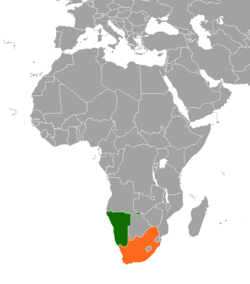 | |
Namibia |
South Africa |
|---|---|
Namibia–South Africa relations refers to the current and historical relationship between Namibia and South Africa. South Africa (then part of the British Empire as the Union of South Africa) captured the area now known as Namibia from Germany during World War I and governed it, by the name 'South West Africa', until 1990, when the country gained independence under the name 'Namibia'. During those 75 years, thousands of South Africans settled in the territory and South Africa treated the area as effectively a fifth province of both the Union and the Republic, imposing apartheid laws in South West Africa as it did in South Africa.
Both nations are members of the African Union, Commonwealth of Nations, Southern African Development Community and the United Nations.
South West Africa and Namibian independence (1915-1990)

During World War I, South Africa captured and occupied what was then German South West Africa beginning in 1915.
After the war, the League of Nations removed overseas territories from a defeated Germany and they mandated the territory to South Africa as a trusteeship, as a 'Class C Mandate', known as South West Africa. South Africa proposed that it be allowed to annex South West Africa; a proposal rejected by the United Nations General Assembly as successor to the League of Nations; though the South African government refused to accept the United Nations' authority. As a result, South West Africa continued to be administered directly by South African administrators in Pretoria as if it was a fifth province and many white South African settlers came to the country. South African Apartheid was also introduced into the country and led to the creation of tribal homelands for black inhabitants of the country.
In August 1966, the South African Border War began between the South West Africa People's Organization (SWAPO) and the South African Defence Force. SWAPO's goal was to obtain independence from South African dominance. SWAPO had majority international support and received military assistance from neighboring independent nations, Angola's People's Armed Forces for the Liberation of Angola (FAPLA) and Cuba.
In January 1968, the United Nations Security Council adopted United Nations Security Council Resolution 245 which called for South Africa to end the illegal detention and trial of South West Africans, and then in March they adopted United Nations Security Council Resolution 246 censuring the South African government for failing to comply.
Then in August 1969, they passed United Nations Security Council Resolution 269, declared South Africa's continued occupation of Namibia illegal. In 1971, the Namibian contract workers strike occurred across the country to break the contract labor system and promote independence under SWAPO leadership. Near the end of the strike, many of the workers eventually joined PLAN, fighting in the war for independence. The war lasted until March 1990 with South-West Africa winning its independence and the country was renamed Namibia.
In 1994, South Africa ceded Walvis Bay and the Penguin Islands to Namibia. Walvis Bay was a British colony until World War I. This small enclave was never part of German South West Africa and so had not been part of the mandate territory.
Post-Namibian independence (since 1990)
In 1994, apartheid ended in South Africa and Nelson Mandela was elected President of South Africa. Since then, relations between Namibia and South Africa have remained close. There have been numerous visits between leaders of both nations and several agreements have been signed. The economy of Namibia is also closely linked to South Africa in terms of trade and South African companies have a large number of investments in the key industries in Namibia such as mining, retail, banking and insurance. Namibia contributes greatly to the growth and development of the South African tourism industry. Namibia ranked as South Africa's 9th largest source of tourism.
In 2014, when Namibia was affected by a long drought, South Africa donated 100 million Rand to ease the impact.
Namibia is part of the Common Monetary Area, which means that the South African rand remains in circulation along with the Namibian dollar.
Resident diplomatic missions
- Namibia has a High Commission in Pretoria and a consulate-general in Cape Town.
- South Africa has a High Commission in Windhoek.
See also
References
- Schenoni, Luis (2017) "Subsystemic Unipolarities?"in Strategic Analysis, 41(1): 74-86
- "S/RES/245(1968) - E - S/RES/245(1968) -Desktop". undocs.org. Retrieved 2021-05-21.
- Rogers, Barbara (1972). "Namibia's General Strike". Africa Today. 19 (2): 3–8. ISSN 0001-9887. JSTOR 4185227.
- Moorsom, Richard (April 1979). "Labour Consciousness and the 1971–72 Contract Workers Strike in Namibia". Development and Change. 10 (2): 205–231. doi:10.1111/j.1467-7660.1979.tb00041.x.
- ^ Bilateral relations between South Africa and Namibia
- Nakale, Albertina (5 November 2020). "Mixed fortunes for Zuma N$100m drought donation". New Era. p. 1.
- Namibian high commission in Pretoria
- South African high commission in Windhoek
Further reading
- A New Small State with a Powerful Neighbour: Namibia/South Africa Relations since Independence by Graham Evans, The Journal of Modern African Studies, March 1993
External links
- SA, Namibia push corridor development SouthAfrica.info, 8 November 2010
| Africa |  | |
|---|---|---|
| Americas | ||
| Asia | ||
| Europe | ||
| Europe | ||
| |||||||||||||||
| |||||||||||||||
| |||||||||||||||